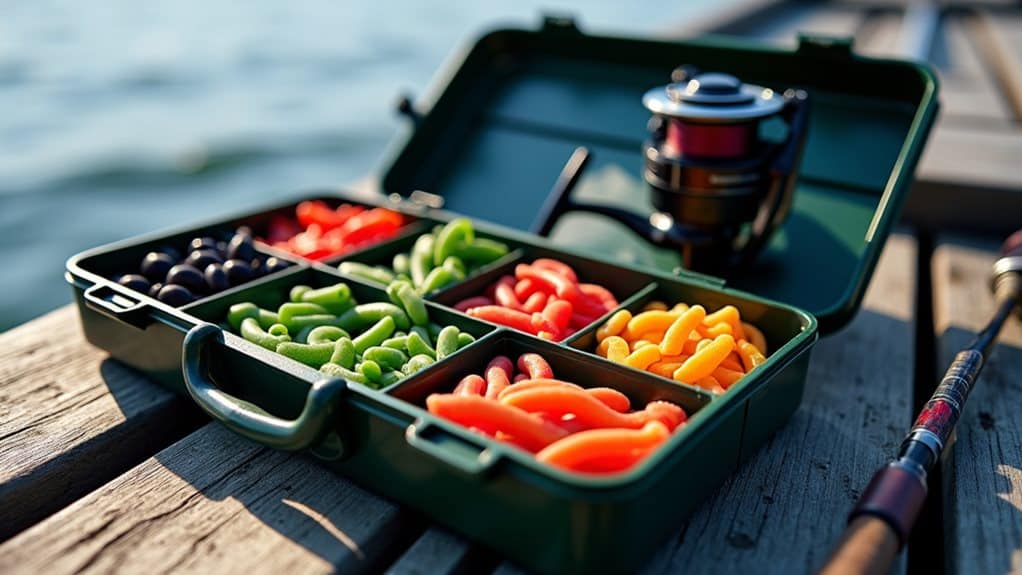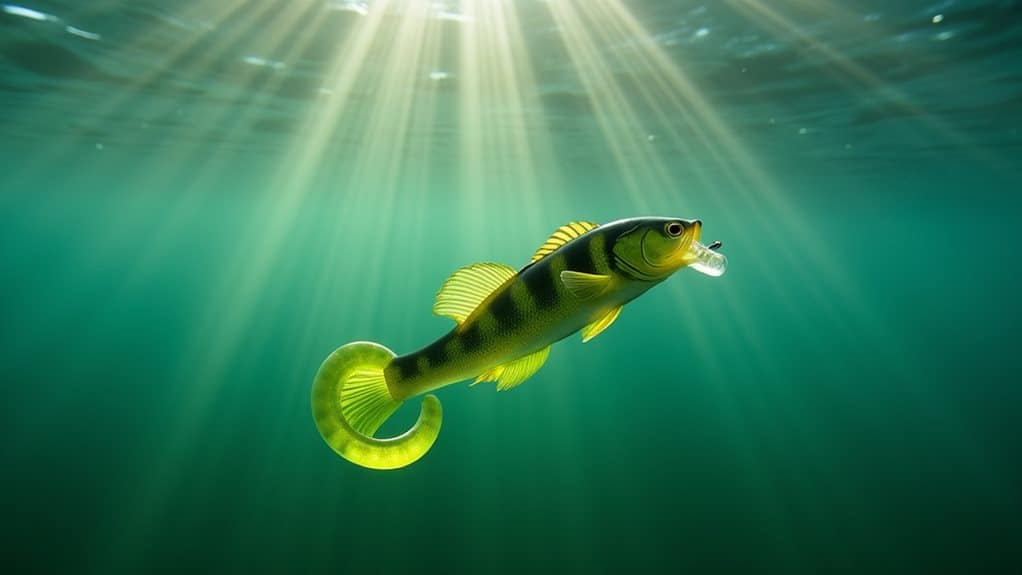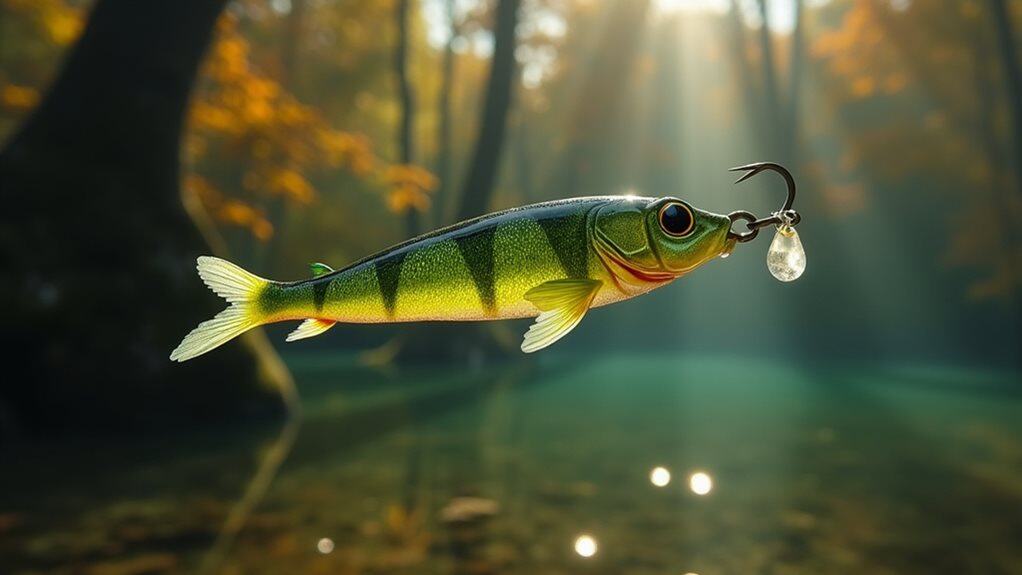You’ll catch more bass with plastic worms by perfecting the Texas rig using a 3/0 offset hook and medium-heavy rod. Choose watermelon or green pumpkin colors in clear water, switching to black in murky conditions. Let the worm hit bottom, then use light twitches with occasional pauses to mimic injured prey. Watch for line slack indicating strikes, then set the hook with sharp upward motion while maintaining steady pressure. The techniques below will enhance your success even further.
TLDR
- Use a Texas rig with 3/0 offset hook and let the sinker slide freely for weedless fishing through heavy cover.
- Match worm colors to conditions: watermelon/green pumpkin for clear water, black/junebug for murky water.
- Retrieve with light twitches and occasional pauses to mimic injured prey while maintaining bottom contact.
- Watch for sudden line slack, then set the hook with sharp upward motion while maintaining steady pressure.
- Avoid moving worms too quickly and practice proper hook setting to maximize your catch success rate.
Essential Gear and Equipment for Plastic Worm Bass Fishing

Before you can successfully target bass with plastic worms, you’ll need to assemble the right combination of gear that matches both your fishing style and the conditions you’ll encounter on the water.
Start with a medium to medium-heavy action rod paired with a spinning or baitcasting reel, then add worm hooks, monofilament or fluorocarbon line, appropriate sinkers, and pliers for safe hook removal. Additionally, consider using a good inexpensive fish finder to help locate bass and enhance your fishing experience. Whether you’re targeting bass in saltwater and freshwater environments, having versatile gear ensures you’re prepared for different fishing scenarios and water conditions.
Understanding Different Types of Plastic Worms
With your gear assembled and ready to go, you’ll find that plastic worms come in an impressive array of styles, each designed to trigger bass strikes under different conditions.
Finesse worms offer subtle action for pressured fish, while magnum worms provide aggressive attraction with ribbed bodies and salt impregnation. Additionally, various rigging methods can be employed to enhance the effectiveness of these worms based on the fishing environment.
Ribbon tail worms create exaggerated underwater movement in clear water. Stick baits like the YUM Dinger family are also popular choices, available in sizes from 3 to 6 inches with their elongated configuration making them highly versatile for various fishing techniques.
Selecting the Perfect Worm Color and Size

Choosing the right color and size for your plastic worm can make the difference between a successful day on the water and going home empty-handed.
Watermelon and Green Pumpkin dominate as versatile choices, effectively mimicking bluegill and crawfish in clear to mildly stained water.
For murky conditions, you’ll want dark colors like Black or Junebug that create contrast and help bass locate your bait. Additionally, fishing in crystal clear water like that found in Waldo Lake can enhance the effectiveness of your chosen colors and sizes.
Mastering the Texas Rig Setup
The Texas rig’s effectiveness depends on three critical components that work together to create the perfect weedless presentation for bass fishing.
You’ll need to select the right offset hook size, typically a 3/0 for most plastic worms, while mastering proper weight placement that allows your sinker to slide freely on the line.
Once you’ve got these elements in place, the weedless rigging method will let you fish through heavy cover where bass love to hide, giving you access to productive waters that other anglers can’t reach. Additionally, using a high-quality ball bearings setup in your rod and reel combo can enhance your sensitivity and overall performance while fishing.
Choosing Proper Hook Size
Success in Texas rig fishing hinges substantially on selecting the right hook size, as this single decision impacts everything from your bait’s natural action to your hookset efficiency.
You’ll want 1/0 to 5/0 offset worm hooks for most applications, scaling up to 4/0 or 5/0 for larger ten-inch worms to guarantee solid penetration and prevent fish loss.
Weight Placement Techniques
Proper weight placement converts your plastic worm from a lifeless piece of soft plastic into a deadly bass magnet, with even subtle adjustments dramatically altering how your bait moves, falls, and triggers strikes.
Position weight closer to the hook for aggressive, darting action, or move it farther away for slower, gliding presentations that tempt finicky bass.
Weedless Rigging Method
Every successful bass angler eventually uncovers that mastering the Texas rig alters plastic worm fishing from hit-or-miss attempts into consistent strikes, especially when targeting bass hiding in heavy cover where traditional rigs would snag constantly.
You’ll thread your offset worm hook through the worm’s nose, exit one-third down, then reinsert the point just beneath the surface for weedless presentation.
Advanced Rigging Techniques for Maximum Success
While basic Texas and Carolina rigs catch plenty of bass, honing advanced rigging techniques can dramatically increase your success rate, especially when fishing pressured waters or challenging conditions.
The Neko rig’s vertical presentation excels around heavy cover, while the Free rig’s bell-shaped weight creates subtle movements that won’t spook finicky bass in clear water situations.
Proven Retrieval Methods and Techniques

Once you’ve perfected the rigging fundamentals, your retrieval technique becomes the deciding factor between a slow day and a memorable fishing experience.
Use light twitches to imitate prey movement after your worm hits bottom. Maintain slow, steady retrieval while keeping bottom contact.
Pause occasionally to mimic injured prey, and maintain taut line to feel strikes instantly.
Prime Fishing Locations and Structure Targeting
When you’re targeting bass with plastic worms, your success depends heavily on identifying the right structural features that attract and hold fish.
You’ll want to focus on areas where depth changes occur, such as drop-offs and ledges, since these shifts create prime feeding zones where bass ambush prey.
Additionally, vegetation and cover like submerged logs, docks, and weed beds provide the hiding spots bass need to feel secure while hunting.
Structural Feature Hotspots
Success in bass fishing with plastic worms depends heavily on your ability to identify and target the right structural features where bass naturally congregate.
Focus on weed bed edges, rocky points, submerged logs, and dock pilings where bass ambush prey. These structures provide cover and feeding opportunities, making them prime locations for consistent catches using proper worm presentations.
Water Depth Transitions
Three critical depth zones define where post-spawn bass position themselves as water temperatures climb and feeding patterns shift throughout late spring and early summer.
You’ll find the most active feeders in that sweet spot between six and twelve feet, where bass are actively migrating from shallow spawning areas to deeper summer haunts along natural passage routes.
Vegetation and Cover
Nothing attracts bass quite like vegetation and cover, which serve as both hunting grounds and sanctuary for these opportunistic predators.
Target submerged fish beneath thick mats using weighted Texas-rigged worms in green pumpkin or watermelon colors. Punch through surface vegetation, then hop your worm slowly.
Focus on vegetation edges, laydowns, and lily pad drop-offs where bass ambush prey.
Reading Water Conditions for Optimal Presentation
When you’re preparing to fish a plastic worm, understanding water conditions becomes the foundation for determining how, where, and when to present your lure effectively.
Temperature dictates bass activity levels and depth preferences, while current flow reveals energy-conserving ambush spots behind structures.
Wind direction concentrates baitfish and bass along windward shores, and water clarity determines your color selection and retrieval speed.
Seasonal Strategies for Year-Round Success

Controlling water conditions sets the stage for applying the right techniques throughout the year, as bass behavior shifts dramatically with each season’s unique challenges and opportunities.
You’ll need finesse presentations in early spring, aggressive tactics during late spring spawning, deeper approaches for summer heat, and bulky provisions during fall feeding frenzies before winter’s slow presentations.
Professional Tips for Hook Setting and Fighting Fish
Although many anglers can successfully entice bass to strike a plastic worm, the difference between catching fish and losing them often comes down to proper hook setting and fighting techniques.
Watch for sudden line slack, then reel quickly before setting the hook with a sharp upward motion.
Maintain steady pressure during the fight while keeping your rod tip raised.
Common Mistakes to Avoid When Fishing Plastic Worms

Even experienced anglers who’ve perfected the basics of plastic worm fishing can sabotage their success through seemingly minor mistakes that compound over time.
Over-spooling your reel reduces casting control, while incorrect line weight diminishes bite sensitivity.
Pegging sinkers unnaturally, moving worms too quickly, and failing to pause during retrieval frequently cost you strikes that should’ve been easy catches.
Final Note
You’ve now got the essential knowledge to fish plastic worms like a seasoned pro. Remember, success comes from consistent practice and paying attention to details—proper rigging, color selection, and reading water conditions. Don’t get discouraged if you don’t catch fish immediately; even experienced anglers face challenging days. Keep experimenting with different techniques, stay patient, and you’ll develop the instincts needed to consistently land bass using plastic worms.




